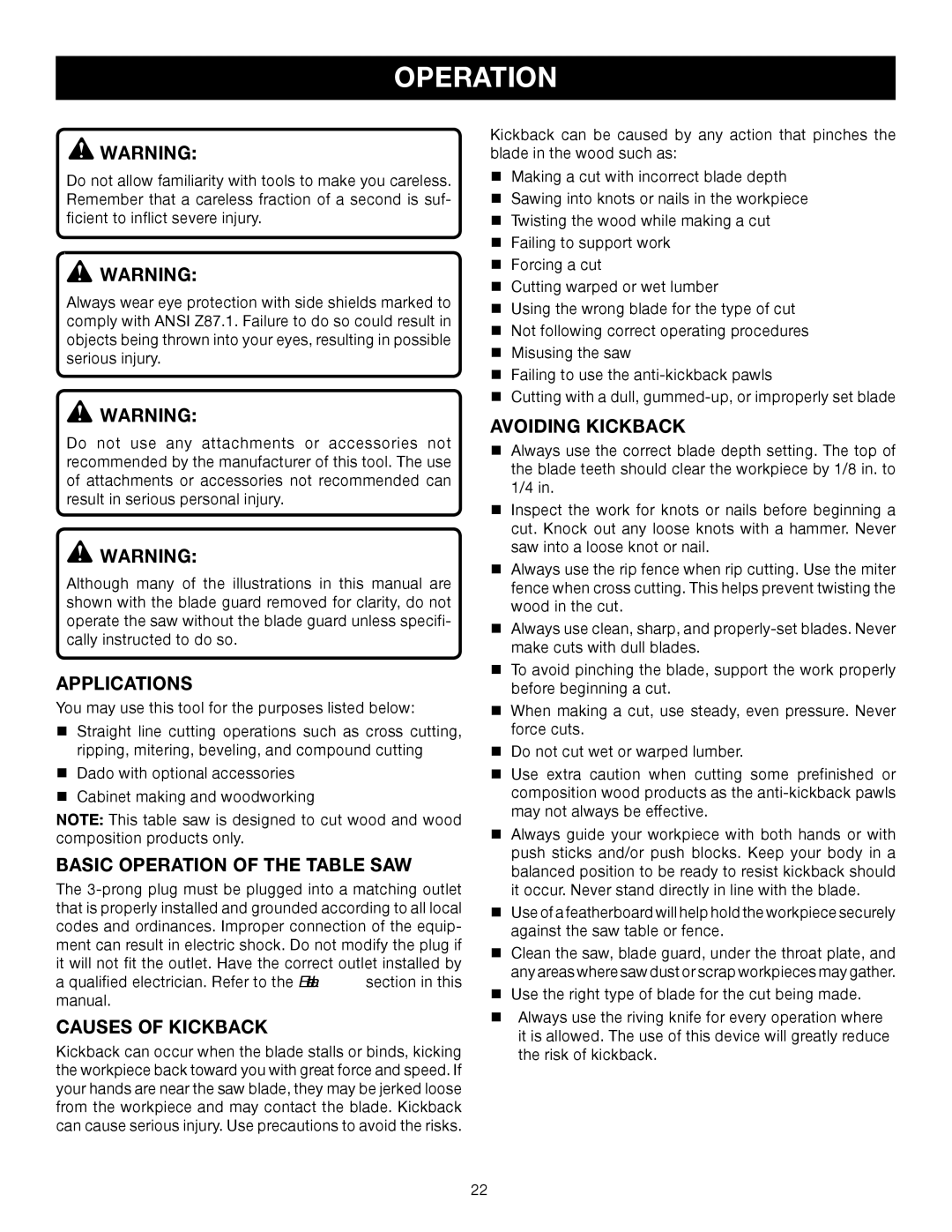
OPERATION
![]() WARNING:
WARNING:
Do not allow familiarity with tools to make you careless. Remember that a careless fraction of a second is suf- ficient to inflict severe injury.
![]() WARNING:
WARNING:
Always wear eye protection with side shields marked to comply with ANSI Z87.1. Failure to do so could result in objects being thrown into your eyes, resulting in possible serious injury.
![]() WARNING:
WARNING:
Do not use any attachments or accessories not recommended by the manufacturer of this tool. The use of attachments or accessories not recommended can result in serious personal injury.
![]() warning:
warning:
Although many of the illustrations in this manual are shown with the blade guard removed for clarity, do not operate the saw without the blade guard unless specifi- cally instructed to do so.
APPLICATIONS
You may use this tool for the purposes listed below:
Straight line cutting operations such as cross cutting, ripping, mitering, beveling, and compound cutting
Dado with optional accessories
Cabinet making and woodworking
NOTE: This table saw is designed to cut wood and wood composition products only.
Basic Operation of the TABLE Saw
The
CAUSES OF KICKBACK
Kickback can occur when the blade stalls or binds, kicking the workpiece back toward you with great force and speed. If your hands are near the saw blade, they may be jerked loose from the workpiece and may contact the blade. Kickback can cause serious injury. Use precautions to avoid the risks.
Kickback can be caused by any action that pinches the blade in the wood such as:
Making a cut with incorrect blade depth
Sawing into knots or nails in the workpiece
Twisting the wood while making a cut
Failing to support work
Forcing a cut
Cutting warped or wet lumber
Using the wrong blade for the type of cut
Not following correct operating procedures
Misusing the saw
Failing to use the
Cutting with a dull,
AVOIDING KICKBACK
Always use the correct blade depth setting. The top of the blade teeth should clear the workpiece by 1/8 in. to 1/4 in.
Inspect the work for knots or nails before beginning a cut. Knock out any loose knots with a hammer. Never saw into a loose knot or nail.
Always use the rip fence when rip cutting. Use the miter fence when cross cutting. This helps prevent twisting the wood in the cut.
Always use clean, sharp, and
To avoid pinching the blade, support the work properly before beginning a cut.
When making a cut, use steady, even pressure. Never force cuts.
Do not cut wet or warped lumber.
Use extra caution when cutting some prefinished or composition wood products as the
Always guide your workpiece with both hands or with push sticks and/or push blocks. Keep your body in a balanced position to be ready to resist kickback should it occur. Never stand directly in line with the blade.
Use of a featherboard will help hold the workpiece securely against the saw table or fence.
Clean the saw, blade guard, under the throat plate, and any areas where saw dust or scrap workpieces may gather.
Use the right type of blade for the cut being made.
Always use the riving knife for every operation where it is allowed. The use of this device will greatly reduce the risk of kickback.
22
